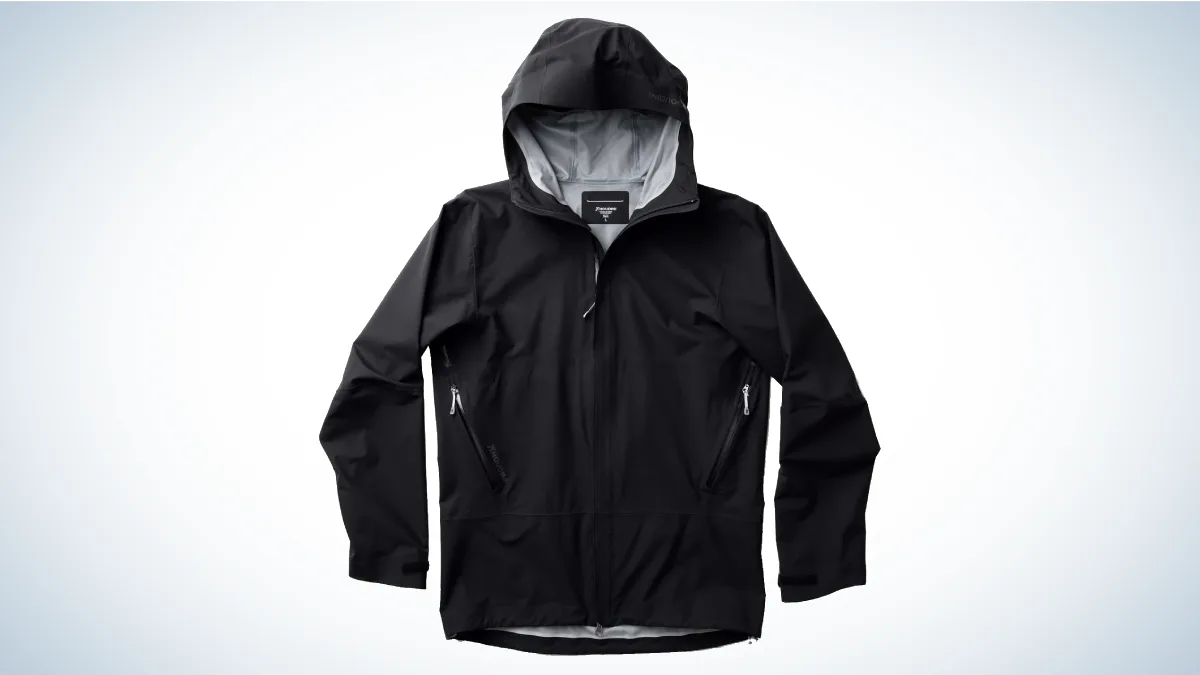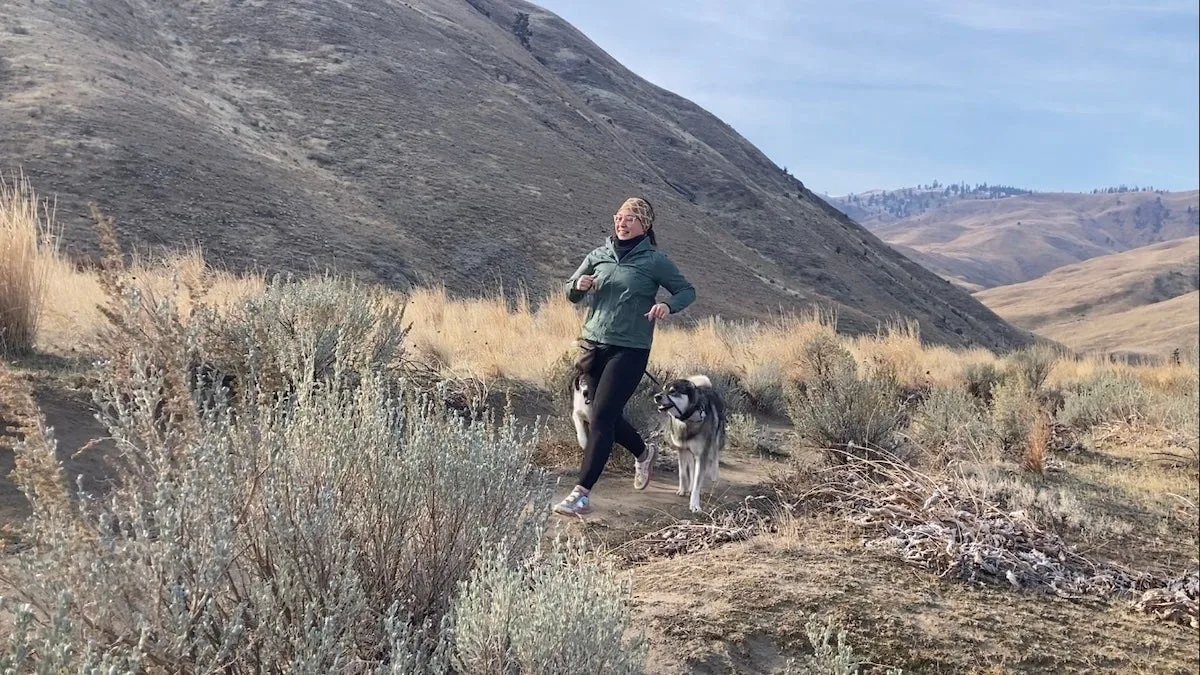_We may earn revenue from the products available on this page and participate in affiliate programs. Learn more ›
_
Best Overall

Ibex Wool Aire Hoodie
Best Rain Jacket

Houdini BFF Jacket
Best Fleece

No matter the time of year I’m hiking, I always pack a jacket, but hiking jackets vary greatly depending on the environment and season. While a soft shell windbreaker might be the perfect choice for a fall desert hike, a winter trek requires multiple layers of insulation. When it comes to the gear you take on the trail, there’s arguably none as crucial as the right jacket for your journey.
It can be overwhelming to shop for a hiking jacket that fits all your needs, and honestly, it is common to invest in more than one to match activity and changing seasons. We’ve spent many seasons—including rainy and cold weather—trekking the trails and we’ve learned what to look for in outerwear. Ultimately, the best hiking jackets protect the hiker from the weather, provide comfort through strenuous activity, and shield you from the elements.
Best Overall: Ibex Wool Aire Hoodie
Best Rain Jacket: Houdini BFF Jacket
Best for Women: Jack Wolfskin Prelight 2.5L Jacket
Best for Men: Patagonia Nano Puff Jacket
Best Windbreaker: Icebreaker Shell+ Merino Cotton Windbreaker
Best for Summer: Free Fly Headwind Jacket
Best for Cold Weather: Nathan Sports Puffer Jacket
Best Fleece: Smartwool Hudson Trail Fleece Full Zip
How We Picked The Best Hiking Jackets
For this article, I tested what seemed like a never-ending list of hiking jackets over multiple months. From hot summer days to frozen summits, I put these jackets through the ringer. My experience as a hiking enthusiast and wilderness guide has made me extremely picky about the gear I wear into the backcountry. While testing hiking jackets for this article, I based my choices on the following criteria:
Protection: The main purpose of a hiking jacket is to protect you against the elements. While testing, I experienced hot sunny days, wet fall weather, and frigid winter summits. I evaluated each to determine if they delivered the appropriate level of defense against the elements they were designed for. They also needed to provide a breathable barrier that let moisture escape as I exerted myself on the trail.
Functionality: Does this jacket do what it’s intended? An ultralight jacket and a heavily insulated puffer serve very different purposes, but they both must perform the job they were designed for. Additionally, features like pockets to stash a phone, keys, dog treats, etc. can make the jacket more useful, but add bulk. I looked for a balance of features, weight, and usability in my picks.
Fit: Fit is one of the most important criteria in choosing a jacket. I once spent months researching hiking rain jackets
, buying an expensive coat, and then having it fit poorly. I quickly realized that no matter how breathable and waterproof my jacket was, it didn’t matter if the sleeves weren’t long enough, and the hood didn’t cover my nose. Since fit is highly variable based on body type, I highly recommend researching the sizing information for the brand you choose.
The Best Hiking Jackets: Reviews & Recommendations
Best Overall: Ibex Wool Aire Hoodie
Best Overall

Specs
Sizes: S – XXL
Weight: 11.3 oz
Materials: 100% Nylon (shell), 80% Merino Wool / 20% Polyester (insulation)
Water Resistance: Moisture-wicking materials
Hooded: Yes
Pros
Ultra-lightweight materials
PFC-free, Bluesign Certified materials, Oeko-tex Certified dyes, and renewable raw materials for insulation
Available in a variety of colors
Excellent weight-to-warmth ratio
Easy to clean
Cons
Women’s jacket design is slightly less functional than men’s
Would be nice to have larger sizing options
If you need a new jacket to add to a killer layering system, look no further than the Ibex Wool Aire Hoodie. Do not let the lightweight design fool you! This jacket has an excellent weight-to-warmth ratio. It is the perfect jacket to keep on hand for shoulder seasons or for winter activities like cross-country skiing, snowshoeing, running, and hiking. While this is a soft shell, it has moisture-wicking capacities, and the jacket fit is ideal in a layering system.
This jacket is also a real standout because it’s PFC-free and made with Bluesign-certified materials and Oeko-tex certified dyes. It also uses primarily merino wool as its insulation (80% merino wool and 20% polyester). Not only is wool a stellar insulator, but the materials make it especially easy to keep clean.

I like how comfortable this Ibex jacket is for hiking and other outdoor activities. Meg Carney
In my testing, I was initially concerned about the jacket’s light weight. But with use, especially during cold weather hikes and trail runs, I found it provided a comfortable outdoor experience. The hood’s fit is also ideal for movement or high winds as it fit snuggly around my neck and face. The merino wool insulation is a real game changer with this jacket because you get the benefits of an insulated jacket while still getting the thermo-regulating properties of wool.
While the men’s and women’s jackets share the same materials and warmth, the women’s jacket doesn’t come with a chest pocket like the men’s. This is not a big deal, but having the same features and functionality for both jackets would be nice. Regardless, the Ibex Wool Aire Hoodie is a top-notch choice for the active outdoors person. It is stylish enough to wear around town and functional enough to be your go-to jacket during the shoulder seasons and high-intensity winter workouts.
Best Rain Jacket: Houdini BFF Jacket
Best Rain Jacket

Specs
Sizes: XS – XL
Weight: 12 oz
Materials: 70% Eco Circle recycled polyester, 30% polyester, Atmos, 100% polyester membrane
Water Resistance: DWR finish – PFAS-free
Hooded: Yes
Pros
Made from recycled materials and recyclable
PFAS free
Excellent coverage and protective features
Comfortable fit and feel
Quiet materials even while hiking
Lightweight for durability and performance
Cons
Price
Limited sizing options
The Houdini BFF Rain Jacket stands up to its name and has quickly become my best friend on all my outdoor adventures, which is how it also won our award for the best rain jacket
overall. It has such a loose fit and quiet feel that I first questioned whether or not it would be water-resistant—but the durability and functionality have proven themselves in rain and snow. There is adequate ventilation when hiking in the rain, so even though the jacket is heavier, it does a decent job of providing some airflow. It features a dual zipper system, under-arm zippers, and relatively breathable material.
The Atmos membrane used in the jacket design is a hydrophilic membrane. This means that it is not microporous, but at the molecular level of the fabric, it moves moisture through the fabric away from your body. There is currently no other membrane I know of on the market with the same performance level and sustainable materials in a rain jacket.
Best for Women: Jack Wolfskin Prelight 2.5L Jacket
Best for Women

Specs
Sizes: XS – XL
Weight: 9 oz
Materials: 100% Polyamide
Water Resistance: Waterproof
Hooded: Yes
Pros
Lightweight and packable
Water- and windproof
Fairly breathable
Very versatile
Cons
Somewhat noisy fabric material
Price
The Jack Wolfskin PreLight 2.5L is a highly versatile jacket for hiking, backpacking, hunting, and more. It is surprisingly durable for its lightweight design and works as a shell for nearly every season. It is waterproof and windproof, making it one of my go-to jackets for blustery hikes or rainy trail runs. It packs down exceptionally small, which is also why I love to bring it running. It can easily be stuffed into a running vest or a hunting vest. This also makes it a fantastic backpacking rain jacket
.

This jacket is light enough for trail runs—I wear it often while working out outdoors. Meg Carney
I opt for higher-performing rain jackets for extreme weather, but the versatility of this jacket is hard to match. If you’re looking for a lightweight and packable jacket, perfect for layering on any hike or hunt, this is one of my favorite picks.
Best for Men: Patagonia Nano Puff Jacket
Best for Men

Specs
Sizes: XS – 3XL
Weight: 11.9 oz
Materials: PrimaLoft gold insulation and polyester shell and lining
Water Resistance: Water-resistant
Hooded: No
Pros
Warm
Breathable
Lightweight and packable
Cons
Not waterproof
A favorite of hikers everywhere, the Patagonia Nano Puff can act as an all-season jacket: an outer layer in spring and summer and mid-layer in fall and winter. Warm, yet breathable, this jacket has a great fit to most body types and packs into its own pocket.
Although not waterproof, it still insulates even when wet with PrimaLoft Gold insulation. This jacket is also eco-friendly. Made of 100% recycled polyester with Fair Trade Certified labor, it is Bluesign-approved. The shell is made of 100% recycled polyester ripstop with a DWR finish that is soft and flexible.
Best Windbreaker: Icebreaker Shell+ Merino Cotton Windbreaker
Best Windbreaker
Specs
Sizes: XS – XL
Weight: 7.4 oz
Materials: 100% cotton mesh and merino wool
Water Resistance: Water-repellent
Hooded: Yes
Pros
Highly packable
Breathable mesh panels
Fitted hood
Made from natural materials
Cons
Not very many pockets
The Icebreaker Shell+ Merino Cotton Windbreaker is a hiking and trail running dream jacket. Made from all-natural materials, it’s water-resistant enough for me to wear on runs in light rain and stay dry. The mesh panels improve overall breathability during activities but don’t sacrifice wind protection due to their placement. It’s a comfortable jacket, and although it is water-resistant, it remains quiet while moving since it is made from wool and cotton.

I love that this Icebreaker jacket is both wind- and water-resistant for rainy day hikes. Meg Carney
I know they say that you shouldn’t wear cotton hiking, but there are always exceptions, and this is one of them. I’ve found this jacket well-suited to various outdoor activities and performs well even in light rains. The bulk of the jacket is made from wool, which means it insulates even when wet and has improved thermoregulating properties. It also reduces odors. The only thing I wish this jacket had is more pockets.
Best for Summer: Free Fly Headwind Jacket
Best for Summer

Specs
Sizes: XS – XL
Weight: 50 GSM
Materials: 45% recycled nylon, 55% nylon + DWR
Water Resistance: Water-repellent
Hooded: Yes
Pros
Lightweight and packable
True to fit and sizing
Great mobility for hiking, running, or fishing
Ideal wind protection
Cons
No pockets
Even though it is sometimes hard to justify packing a jacket on a warm summer hike, the weather can be unpredictable, especially in the mountains. If you’re like me and prefer a small day hiking pack or want to cut weight backpacking, a lightweight jacket like the Free Fly Headwind Jacket is one of the best picks. It is even small enough to pack down into a fly fishing vest
.

The Free Fly Headwind jacket is lightweight enough to wear on balmy summer hikes. Meg Carney
The simple lightweight design limits some applications but it also makes it perfect for breezy summer evenings or even light rain. It isn’t completely waterproof, but I’ve worn this out in short storms or a drizzle, and it kept me dry. While I wish it had some pockets, there isn’t much to complain about with this jacket. It packs down exceptionally small, the wind and water resistance matches the summer seasons, and it is available in a handful of aesthetically pleasing muted colors.
Best for Cold Weather: Nathan Sports Puffer Jacket
Best for Cold Weather

Specs
Sizes: XS – XL
Materials: Pertex 100% recycled polyester, sustainable 95% recycled polyester, 5% feathers
Water Resistance: Water-resistant
Hooded: Yes
Pros
Mostly synthetic fill makes it easy to wash and care for
Ideal fit for layering and insulating
Continues to insulate when wet
Adequate water resistance to keep the jacket dry in snow
Durable materials
Maintains loft well even with heavy use and packing
Great quality for the price
Cons
Made from 100% polyester
The Nathan Puffer jacket is my go-to all-around ideal winter jacket. It is stylish enough to wear out running errands and technical enough for me to wear on winter hikes and backpacking treks. While I don’t love that it is made from all synthetic materials, it performs exceptionally well. It isn’t completely waterproof but has enough water resistance to keep you warm and dry during heavy snowfall and even light rains. The synthetic insulation continues to insulate should the jacket get wet and maintains its loft even when packed and with heavy use.

This puffer coat is my favorite hiking jacket for winter weather. Meg Carney
I wore this jacket every day last winter, and it served me well. While polyester materials are known for holding onto odors, because they use synthetic insulation, it is easy to keep clean. You can machine wash this jacket, and it dries pretty fast. Overall, this jacket is affordable for the level of performance and durable enough to last you several winters both on and off the trail.
Best Fleece: Smartwool Hudson Trail Fleece Full Zip
Best Fleece

Smartwool Hudson Trail Fleece Full Zip Smartwool
Specs
Available Sizes: XS – XL
Weight: N/A
Materials: 45% wool, 45% polyester, 5% nylon
Water Resistance: Minimal
Hooded: No
Pros
Warm midweight fleece
Odor-resistant
Breathable
Cons
Not fully waterproof
The Smartwool Hudson Trail Fleece will work well as an outer layer in cool weather as well as a great choice for an insulative midlayer in extreme cold. As the best fleece hiking jacket, it is an ideal piece for the shoulder seasons and deep into winter.
The wool/poly blend is warm and isn’t itchy like some wool garments can be. This fleece has roomy hip pockets as well as a zippered chest pocket. The thumb slits on the women’s model keep the sleeves in place when putting on a shell or under gloves.
When testing, this sweater got sweaty and also wet from snow. The wool kept me warm even when damp as well as naturally resisting odor. Lastly, I loved the look of this sweater that could easily be used when not hiking as well.
What to Consider When Choosing a Hiking Jacket
When choosing a hiking jacket, it’s important to consider the environment you need it for, the activity in which you will be partaking, and then find a jacket that is the right fit for you. Whatever you choose, keep the following in mind:
Material
The phrase “cotton kills” might sound a little extreme, but the fact is that cotton traps moisture near your skin and blocks the body’s ability to regulate temperature. Therefore, as you sweat in a cotton shirt, hoodie, or denim, you’re putting stress on your body’s ability to keep warm in winter and cool down in summer. Instead, choose jackets made of wool, polyester, and/or nylon. These materials wick moisture and insulate even when wet.
Layering
There’s not going to be one best hiking jacket for your adventure. Most hikes require layering. For example, start with a non-cotton base layer (like an athletic shirt in summer or merino wool long sleeve in winter) and add a midlayer like a fleece, sweater, or lightweight puffy jacket. Finally, you’ll need an outer layer that consists of a waterproof shell.
Weather, Functionality, and Fit
Weather and season should be an obvious consideration when choosing a jacket. Summer jackets tend to be lightweight and breathable whereas winter hiking jackets provide more protection against precipitation and are often insulated.
Function plays an important role as well. For long day hikes and backpacking, priority should go to breathability and lightweight materials. On casual short hikes near home, overall comfort outweighs the benefits of ultralight material. Lastly, if hiking is a means to another form of recreation like hunting, fieldwork, climbing, or fishing, consider if you need features on your jacket that a typical hiker could overlook. For example, a hood that fits a climbing helmet, a ripstop fabric that won’t easily tear, or a color for concealment.
Lastly, the best hiking jacket is one that fits you well and is comfortable. Make sure to try on your purchase before taking it into the wild. Check arm length, hood coverage, and the ability to layer under and over if needed.
And don’t forget the rest of your body. Check out or guide to hiking pants
and hiking socks
when considering your layering system.
FAQs
Q: What are the different types of hiking jackets?
The different types of hiking jackets can be broken down into two main categories: outer layer and mid-layer. Most outer layers available are rain shells, hard shells, and soft shells. Whereas mid-layer jackets are fleece or puffers.
A soft shell jacket is my pick for most hiking excursions since it is flexible and weather resistant. When experiencing extreme weather, a hard rain shell is better. If in need of insulation, choose fleece or puffer to keep warm. Note that goose down and cotton cannot insulate when wet, so if you’re going to sweat during your hike, it’s best to have synthetic down, polyester, or wool fleece.
Q: How long do hiking jackets last?
How long a hiking jacket lasts depends on the materials, construction, and intensity of use. If you’re hiking every day, a hiking jacket is bound to wear out faster, but with the right care and investment into durable materials, a hiking jacket can last several seasons of hiking.
Q: What is the best packable rain jacket?
I tested many jackets for this piece, and a lot didn’t make it in the article. The best packable rain jacket I encountered was the Outdoor Research Helium Jacket
. It is super light, packable, and comfortable. Other rain jackets were better at waterproofing but couldn’t pack down to a small size. The OR Helium is a great choice to stash in your pack in case you get caught in the rain.
Q: Are waterproof jackets really waterproof?
For a jacket to be truly waterproof, it would have to be made of rubber or plastic. However, this isn’t great for hiking, as these materials also keep moisture in. As you hike, you want your jacket to transfer the heat and moisture you’re generating out of the jacket while at the same time prevent rain from entering. The solution is tightly woven fabrics like Gore-Tex that will allow water vapor like sweat to escape while still providing rain protection. Most shells are also coated in a durable water repellent (DWR), which helps keep water out.
Q: Are hiking jackets quick-drying?
Many hiking jackets are quick-drying, but it depends on the materials. Waterproof and water-resistant jackets tend to be faster drying than options made from materials like cotton.
Q: What is the best color for a hiking jacket?
The best color for a hiking jacket is the one that you like the most! I generally recommend that people try to incorporate some high-visibility colors into their hiking wardrobes to make their location visible in case of an emergency or search and rescue situation.
Best Hiking Jackets: Final Thoughts
Best Overall: Ibex Wool Aire Hoodie
Best Rain Jacket: Houdini BFF Jacket
Best for Women: Jack Wolfskin Prelight 2.5L Jacket
Best for Men: Patagonia Nano Puff Jacket
Best Windbreaker: Icebreaker Shell+ Merino Cotton Windbreaker
Best for Summer: Free Fly Headwind Jacket
Best for Cold Weather: Nathan Sports Puffer Jacket
Best Fleece: Smartwool Hudson Trail Fleece Full Zip
Hiking jackets protect against the elements and provide comfort on your trek. If you hike regularly, you will need to have a couple jackets that you can layer. These should include a warm, insulating jacket like a fleece or puffer as well as a protective wind and rain shell. The best hiking jackets are the ones that meet your needs for the hike, suit the weather at hand, and fit you well.
Why Trust Us
For more than 125 years, Field & Stream has been providing readers with honest and authentic coverage of outdoor gear. Our writers and editors eat, sleep, and breathe the outdoors, and that passion comes through in our product reviews. You can count on F&S to keep you up to date on the best new gear. And when we write about a product—whether it’s a bass lure or a backpack—we cover the good and the bad, so you know exactly what to expect before you decide to make a purchase.






